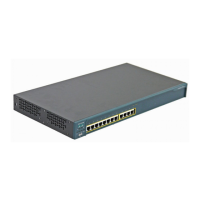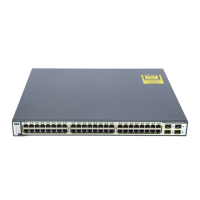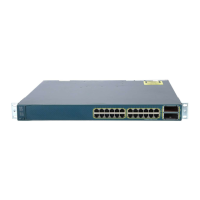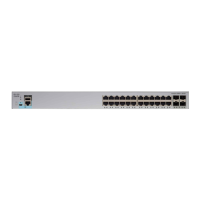52-11
Catalyst 6500 Series Switch Software Configuration Guide—Release 8.7
OL-8978-04
Chapter 52 Configuring QoS
Understanding How QoS Works
PFC3A/PFC3B/PFC3BXL provides QoS for the ingress and egress traffic. PFC2 and PFC provide QoS
only for the ingress traffic.
With PFC3, QoS supports map-based egress DSCP mutation, which allows you to remark the egress
traffic after it has been subjected to a policing rule, and the option to preserve the received DSCP in the
egress traffic.
The ACLs contain the access control entries (ACEs) that specify the Layer 2, 3, and 4 classification
criteria, a marking rule, and policers. Marking sets the Layer 3 IP precedence or DSCP values and the
Layer 2 CoS value to either the received or configured Layer 2 or Layer 3 values. Policing uses
bandwidth limits to either drop or mark the nonconforming traffic. For more information, see the
“Classification, Marking, and Policing with a Layer 3 Switching Engine” section on page 52-15.
During processing, a Layer 3 switching engine associates a DSCP value with all traffic, including non-IP
traffic. For more information, see the “Internal DSCP Values” section on page 52-16.
Layer 2 Switching Engine Features
With a Layer 2 Switching Engine, QoS can classify traffic using the Layer 2 destination MAC addresses,
VLANs, and marking using the Layer 2 CoS values. Classification and marking with a Layer 2
Switching Engine do not use or set the Layer 3 IP precedence or DSCP values. For more information,
see the “Classification and Marking on a Supervisor Engine 1 with a Layer 2 Switching Engine” section
on page 52-28.
Ethernet Egress Port Features
With any switching engine, QoS supports Ethernet egress port scheduling and congestion avoidance
using the Layer 2 CoS values. Ethernet egress port marking sets the Layer 2 CoS values and, with a
Layer 3 switching engine, the Layer 3 DSCP values. For more information, see the “Ethernet Egress Port
Scheduling, Congestion Avoidance, and Marking” section on page 52-28.
Single-Port ATM OC-12 Switching Module Features
The ingress interface from a single-port ATM OC-12 switching module is untrusted, and QoS sets CoS
to zero in all traffic that is received from it. With a Layer 3 switching engine, QoS can mark the IP traffic
that is transmitted to a single-port ATM OC-12 switching module with the Layer 3 DSCP values.
Multilayer Switch Feature Card (MSFC, MSFC2, or MSFC3)
QoS marks the IP traffic that is transmitted to an MSFC with the Layer 3 DSCP values. The CoS is zero
in all traffic that is sent from an MSFC to the egress ports.
Note The traffic that is Layer 3 switched does not go through the MFSC and retains the CoS value that is
assigned by the Layer 3 switching engine.
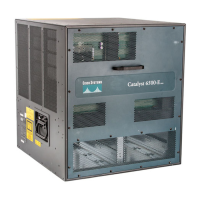
